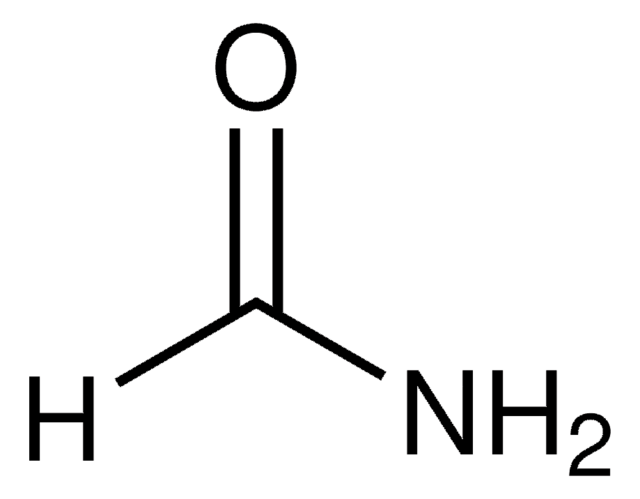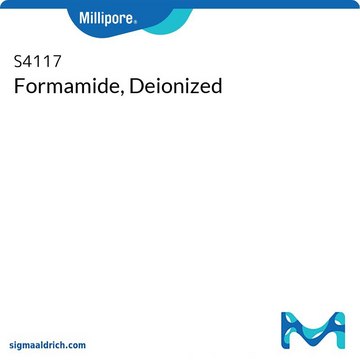F9037
Formamid
BioReagent, ≥99.5% (GC), for molecular biology
Synonym(e):
Amid C1, Formamid
About This Item
Empfohlene Produkte
Qualität
for molecular biology
Qualitätsniveau
Dampfdichte
1.55 (vs air)
Dampfdruck
0.08 mmHg ( 20 °C)
30 mmHg ( 129 °C)
Produktlinie
BioReagent
Assay
≥99.5% (GC)
Form
liquid
Selbstzündungstemp.
932 °F
Methode(n)
electrophoresis: suitable
immunohistochemistry: suitable
Brechungsindex
n20/D 1.447 (lit.)
pH-Wert
4-10 (20 °C, 200 g/L)
bp
210 °C (lit.)
mp (Schmelzpunkt)
2-3 °C (lit.)
Dichte
1.134 g/mL at 25 °C (lit.)
Eignung
suitable for nucleic acid hybridization
Lagertemp.
2-8°C
SMILES String
NC=O
InChI
1S/CH3NO/c2-1-3/h1H,(H2,2,3)
InChIKey
ZHNUHDYFZUAESO-UHFFFAOYSA-N
Suchen Sie nach ähnlichen Produkten? Aufrufen Leitfaden zum Produktvergleich
Allgemeine Beschreibung
Anwendung
Weitere Anwendungen sind:
- Herstellung von Maus-Gehirnschnitten für BrdU-Immunhistochemie
- FISH-Analyse von HeLa-Zellen.
- Herstellung von Polyacrylamid-Gel für die Analyse von PCR-Produkten unter Verwendung von denaturierender Gradientengelelektrophorese (The Merck Index, 12. Ausgabe).
Leistungsmerkmale und Vorteile
- Entionisiert für Anwendungen in der Molekularbiologie.
- Zum Schutz vor Oxidation unter Argongas in Braunglasflaschen abgefüllt.
- Wird verwendet für DNA-Renaturierung und DNA-RNA-Hybridisierung
- Reduziert die thermische Stabilität von doppelsträngigen Nukleinsäuren
Eignung
- Nukleinsäurehybridisierung
- Gefrierschutzmittel und Gelstabilisator
- Destabilisieren von Nukleinsäure-Doppelhelixen
- Beseitigung der Sekundärstruktur von Nukleinsäuren
- Herstellung von Hybridisierungspuffern für RNA- und DNA-Anwendungen
Sonstige Hinweise
Ähnliches Produkt
Signalwort
Danger
H-Sätze
Gefahreneinstufungen
Carc. 2 - Repr. 1B - STOT RE 2 Oral
Zielorgane
Blood
Lagerklassenschlüssel
6.1C - Combustible acute toxic Cat.3 / toxic compounds or compounds which causing chronic effects
WGK
WGK 1
Flammpunkt (°F)
305.6 °F
Flammpunkt (°C)
152 °C
Persönliche Schutzausrüstung
Eyeshields, Gloves, type ABEK (EN14387) respirator filter
Analysenzertifikate (COA)
Suchen Sie nach Analysenzertifikate (COA), indem Sie die Lot-/Chargennummer des Produkts eingeben. Lot- und Chargennummern sind auf dem Produktetikett hinter den Wörtern ‘Lot’ oder ‘Batch’ (Lot oder Charge) zu finden.
Besitzen Sie dieses Produkt bereits?
In der Dokumentenbibliothek finden Sie die Dokumentation zu den Produkten, die Sie kürzlich erworben haben.
Verwandter Inhalt
Formamide is a reagent that is an ionizing solvent in aqueous buffers. It is widely utilized in biochemistry and molecular biology, particularly in nucleic acids research.
Unser Team von Wissenschaftlern verfügt über Erfahrung in allen Forschungsbereichen einschließlich Life Science, Materialwissenschaften, chemischer Synthese, Chromatographie, Analytik und vielen mehr..
Setzen Sie sich mit dem technischen Dienst in Verbindung.




